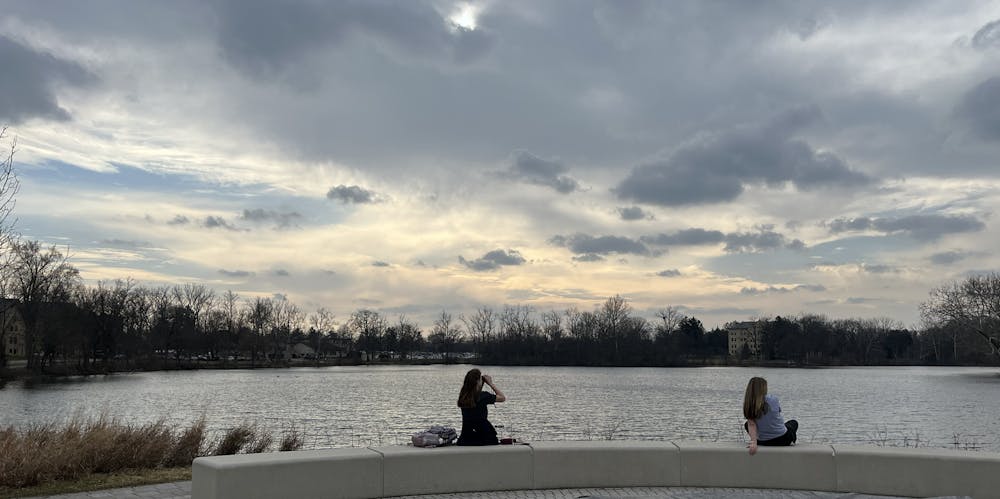Warm weather attracted hoards of students to Notre Dame’s two campus lakes this week. As temperatures climbed into the 70s Tuesday, many students took time off studying to enjoy the lakes’ environment, with scores of runners circling the lakes and other students simply relaxing at the newly constructed Our Lady of the Lake World Peace Plaza.
Senior Mary Capps was one such student, facing the lake with a set of binoculars and a birdwatching guidebook to observe the variety of wildlife on Saint Mary’s Lake.
“There’s lots of raccoons around the lake that like to sleep in trees during the day, which you’ll learn if you look up at the trees a lot,” Capps said. “The waterfowl here is very interesting because in the winter, St. Joe’s Lake never freezes so you get a lot of birds coming down that have concentrated on the lake because all the other bodies of water are frozen.”
Capps said she has seen a lot of goldeneye and hooded merganser at the lakes, among other types of ducks, as well as a variety of warbler songbirds. She has always enjoyed spending time at the lakes during her time as a student, which she says provides the campus with a tranquil environment to deal with the pressures of school.
“It’s a place of beauty,” Capps said. “It can be very stressful studying at Notre Dame, and sometimes you just want to go out on a nice day and just enjoy some sun, enjoy some fresh air, getting away from the stresses of class and everything.”
But it wasn’t always that way, according to Ronald Hellenthal, a professor emeritus of biological sciences who taught aquatic ecology at Notre Dame from 1977 until 2012.

“The origin of the Notre Dame lakes goes back to the last glacial period, maybe 13-14,000 years ago when the glaciers were retreating,” Hellenthal said. “At Notre Dame, when it was founded in the 1840s, there was essentially one lake, but it was actually the product of two relatively close terrestrial icebergs, each one of which had a deep area.”
The shallow area between the two depressions was a swamp, Hellenthal said. The “du Lac” of University of Notre Dame du Lac is singular because “when you looked at the surface, there was one lake.”
The lakes were the University’s source of drinking water, but this water was “terribly contaminated.” A cholera outbreak killed more than 20 Holy Cross brothers between 1847 and 1855, threatening the University’s existence in its first decade.
Epidemiological understandings at the time did not connect the relationship between swamps and cholera, but swamps had been associated with diseases.
“So what they did is they got all of the brothers out there and they hand filled that swampy area and transferred it from a single lake to two lakes,” Hellenthal said.
“There were no grocery stores in 1840,” Hellenthal noted, so the University had to be self-sufficient. The lakes were fundamental to this life, but not for recreational purposes.
Agriculture lined the edge of the lake, with waste from pigs and cattle thrown into them. In the early decades, the marl deposits in Saint Mary’s Lake were used to produce cement and raw materials for brick.
The fresh air Capps and the rest of the University’s students enjoy on a nice day are a distant dream from what the lakes once were to the University.
“If you read early writings of the campus, you almost never hear anything about the lakes and, if you do, it certainly would not be positive,” Hellenthal said. “They must have smelled, they were full of poop. In the early days of the chemistry department, the wastes from the sinks went right into St. Mary's Lake.”
Almost all productive uses of the lakes have faded away over time. The only productive use of the lakes today is from the University’s power plant, which uses water from Saint Joseph’s Lake for cooling purposes.
“As far as I know they've never really seen any evidence that it has any impact on the organisms that are living in the lake,” Hellenthal said. “And there are tight constraints about how warm the water can be when it goes back into St. Joseph Lake. They're not putting it in boiling or anything like that.”
The warmed water recycled back into the lake is why Saint Joseph’s Lake doesn’t freeze in the winter.
“My opinion is that the University is doing the best they can to be good environmental stewards and make the lake so that they can serve [their] purpose, both aesthetically and for the needs of the University,” Hellenthal said. “The lakes are in reasonable conditions, all things considered. I mean, they’re not Alpine, pristine lakes, and they never were.”










